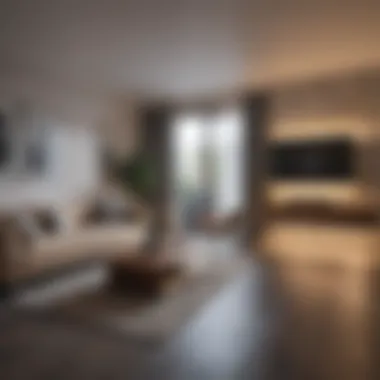Understanding Studio to One Bedroom Apartments


Intro
The transition from a studio apartment to a one bedroom can evoke various emotions and practical considerations, from excitement to challenges. This change often signifies a new chapter in one’s life, whether it's a milestone in a relationship or an adjustment to personal needs. Understanding the factors that play into this decision is essential for not just current living conditions, but also for future planning.
In urban settings where space is at a premium, a studio apartment provides a compact solution for individuals. However, as lifestyles evolve, the need for a designated sleeping area, better storage options, and privacy can lead one to consider a move to a one bedroom apartment. This guide aims to provide a thorough exploration of the essential aspects involved in this transition, ensuring readers can make informed choices based on their unique circumstances.
As we delve into various aspects such as home features, interior design inspirations, and the financial impact of such a move, it becomes clear that understanding both the practical and emotional facets of living arrangements is crucial to creating a comfortable home environment.
Home Features
Architectural Insights
Studio apartments often reflect efficiency in design, utilizing open spaces that foster a sense of functionality. However, when upgrading to a one bedroom apartment, one can expect architectural features that promote distinct living zones. This includes:
- Separate Rooms: One bedroom apartments typically offer a clear delineation between the living area and the bedroom, allowing for a more organized and less cluttered environment.
- Larger Square Footage: Expect an increase in space, which can accommodate additional furnishings or even hobbies.
- Increased Amenities: Often, one bedroom apartments come equipped with additional storage solutions or enhanced kitchen spaces befitting a more settled lifestyle.
Unique Design Elements
Upon transitioning to a one bedroom, the presence of design elements that enhance the living experience becomes more prevalent. These elements can help in establishing a cozy and functional atmosphere:
- Natural Light Sources: Larger windows are common, allowing for more natural light, which positively affects mood and well-being.
- Balconies or Outdoor Areas: Many one bedroom apartments include outdoor spaces, offering a retreat within the urban environment.
- Quality of Materials: An upgrade typically also means better quality finishes, such as hardwood floors or premium appliances, contributing to greater long-term satisfaction.
"Moving to a one bedroom apartment can offer both physical space and psychological comfort, allowing for better organization and personal space."
Interior Design Inspirations
Color Palettes and Themes
Choosing a color palette can dramatically alter the perception of space in both studio and one bedroom apartments. In a one bedroom, the potential to create distinct atmospheres in each room should be considered:
- Warm Tones: Using warm colors can create a cozy environment.
- Cool Tones: Lighter, cool hues can make a space feel more expansive and tranquil.
The theme can also vary significantly:
- Minimalist: Focused on simplicity, reducing clutter to create a sleek look.
- Eclectic: Combining various styles, it reflects personal taste and can make the space feel uniquely yours.
Furniture Arrangement Tips
How furniture is arranged in a one bedroom apartment can maximize the use of space:
- Define Spaces: Use rugs or furniture placement to create separate areas for sleeping, working, and relaxing.
- Multi-functional Furniture: Consider items like a sofa bed or a dining table that can also serve as a workspace.
- Vertical Storage: Utilize walls for shelving to keep floors uncluttered, creating a more open and airy atmosphere.
Foreword to Apartment Types
Understanding different types of apartments is crucial for potential renters or buyers. This guide focuses on two popular options: studio and one bedroom apartments. Grasping the key characteristics of each can help individuals make informed choices that align with their lifestyle, budget, and spatial needs.
Definition of Studio Apartments
A studio apartment is characterized by its open layout. Typically, it combines the living area, sleeping space, and kitchen into one room. The bathroom remains a separate entity. Studio apartments are often chosen by individuals or couples who prioritize efficiency and minimalism. The compact design encourages a streamlined lifestyle, which can be attractive in urban environments where space is at a premium. These apartments usually come at a lower rental price compared to one bedroom units, making them a financially appealing choice.
Definition of One Bedroom Apartments
One bedroom apartments consist of a distinct bedroom that is separated from the living area and kitchen. This separation creates a sense of privacy that is typically absent in studio layouts. One bedroom apartments cater to a broader audience, including small families, couples, and those who desire more space. The additional room allows for various uses—such as an office, guest room, or personal retreat. Generally, one bedroom apartments are larger and more expensive than studios.


Comparison Overview
The main difference between studio and one bedroom apartments is related to space utilization and design. Below are some primary distinctions:
- Space: A studio is all-encompassing, while a one bedroom offers separation.
- Price: Studios are generally cheaper than one bedrooms.
- Privacy: One bedrooms provide more privacy due to the separate sleeping space.
- Usage: A studio is suitable for single occupants, whereas a one bedroom can accommodate couples or small families.
Understanding these differences is pivotal when deciding between the two options.
Key Factors in Choosing Between Studio and One Bedroom
Choosing between a studio and a one-bedroom apartment requires careful consideration. It's not just about the layout or the aesthetics of the place, but also about understanding personal priorities. Factors such as space needs, budgetary limits, and lifestyle impact play a crucial role in making the right choice. Each aspect offers insights that can greatly influence living conditions and experiences in urban settings.
Understanding Your Space Needs
When considering an apartment, first evaluate how much space you truly need. A studio combines living and sleeping areas, often creating an open environment. This works well for individuals or couples who prefer simplicity or have minimal belongings. However, if privacy or separate space is a concern, a one-bedroom may be better.
Think about how you use your living space. Do you require a designated area for work? Perhaps you like hosting friends or need space for hobbies. In a one-bedroom, having that extra area can provide flexibility. Review your current habits and anticipate future needs. Ask yourself if the added space justifies a higher potential rent.
Budget Considerations
Budget is always a significant factor when choosing any living space. Generally, one-bedroom apartments come with increased costs, both in rent and potential maintenance. As a rule of thumb, ansure that your overall expenditure aligns with your financial capacity.
When examining your budget, consider the following aspects:
- Rent Prices: One-bedrooms typically cost more than studios due to their increased space and privacy.
- Utilities: Larger spaces may incur higher utility costs. Always account for these when calculating your monthly budget.
- Furnishing Costs: Studios require less furniture, whereas a one-bedroom may require additional items to furnish extra rooms.
Assessing the total cost can help ground your decision. It’s essential to find a balance that does not stretch your finances too thin.
Lifestyle Impact
Your lifestyle significantly impacts the type of apartment that suits you best. Studio apartments are often seen in bustling urban areas, providing easy access to amenities and vibrant space. They cater to a more dynamic lifestyle. However, they can also be limiting in terms of privacy and the ability to create a personal sanctuary.
Conversely, one-bedroom apartments may appeal to those seeking some solitude. It might work better for couples or individuals wanting to work from home without disturbances. Consider how your living arrangement affects your daily life: work routines, social activities, and overall well-being. A well-suited space can greatly enhance your lifestyle satisfaction.
"Choosing between a studio and a one-bedroom is as much about lifestyle as it is about space and cost. The right choice aligns with your personal and financial goals."
Identifying these key factors allows you to make a more informed decision, ultimately resulting in a living situation that enhances your day-to-day life.
Design Differences: Studio vs. One Bedroom
Understanding the design differences between studio and one bedroom apartments is crucial for making informed living choices. Each layout has its own unique features that cater to different needs and lifestyles. For those considering this transition, knowing the specific elements, benefits, and considerations of each can significantly affect their experience. In this section, we will explore these variations in layout, furnishing options, and storage solutions.
Layout and Flow
The layout of a studio apartment is typically open and flexible. There are no distinct walls separating the living area from the sleeping space. This openness can create a sense of spaciousness and freedom. However, it might also feel less private. One bedroom apartments, in contrast, feature a separate sleeping area, offering more privacy and a designated space for relaxation.
When arranging furniture in a studio, it's important to leverage the open floor plan. For example, using rugs can visually divide spaces and define the living area. Strategic placement of furniture along the boundaries can enhance the flow and functionality. In a one bedroom, the layout allows for more traditional room arrangements. Placing a bed against a wall can free up usable space in the rest of the apartment, providing a more cohesive feel.
Furnishing Options
Furnishing a studio requires creativity and practicality. Since the space is limited, multi-functional furniture is often a necessity. A sofa bed, for example, can serve dual purposes, accommodating both lounging and sleeping needs. Foldable tables and stackable chairs can provide flexibility, allowing the space to adapt based on activity.
In contrast, a one bedroom apartment allows for a more conventional approach to furnishing. With more square footage, one can incorporate larger, dedicated pieces. A queen-sized bed can fit comfortably along with a nightstand and additional furniture such as a dresser. Residents may also have room for a dining table and chairs, enhancing dining experiences.


The choices in furnishing reflect personal style and lifestyle needs. The ability to customize is essential in both types of apartments, but its expression may differ significantly.
Storage Solutions
Storage is a fundamental aspect of apartment design. Studios are generally limited in storage options. Therefore, maximizing vertical space is key. Investing in high bookshelves or wall-mounted shelves can make a difference. Additionally, under-bed storage containers can help keep items organized while minimizing clutter.
One bedroom apartments typically offer more storage potential. There may be built-in closets and additional spaces that can accommodate larger wardrobes and belongings. The separation of living and sleeping areas usually allows for better organization, making it easier to maintain a clear distinction between work and rest.
Ultimately, careful considerations regarding storage can enhance the living experience in both apartments. The choice between a studio and a one bedroom should align with one's lifestyle habits and storage requirements.
"Understanding layout, furnishings, and storage is essential in making informed decisions about the right apartment type for your needs."
Finale
The design differences between studio and one bedroom apartments influence how individuals inhabit these spaces. Layout and flow, furnishing options, and storage solutions play significant roles in the decision-making process. As you consider this transition, reflect on your lifestyle preferences and practical needs. They will guide you toward a more satisfying living experience.
Financial Implications of Upgrading
Understanding the financial implications of upgrading from a studio to a one bedroom apartment is crucial for anyone considering this transition. It is not merely a matter of physically changing your living space; it involves assessing various costs, potential benefits, and even long-term financial strategies.
Rental Costs Overview
When moving from a studio to a one bedroom, rent prices can vary significantly. Typically, one bedroom apartments command higher rental rates in most urban areas. It is essential to research the average rental costs in your desired neighborhood.
- Local Market Trends: Prices can depend on overall real estate trends. Some neighborhoods may have one bedroom apartments at only a slight premium over studios, whereas in other regions, the cost might double or more.
- Amenities Included: Consider not just the base rent but also what is included. Some one bedroom apartments have extra features like laundry facilities or recreational areas, which can affect overall affordability.
- Lease Terms: Negotiating lease terms is important too. A longer lease may provide cost savings.
Utility Expenses
Upgrading can also affect your utility expenses. One bedroom apartments might entail higher utility costs due to larger space and possibly increased usage of heating or air conditioning. Here are a few considerations regarding utilities:
- Heating and Cooling Needs: More square footage may require more energy to maintain a comfortable temperature.
- Water and Waste: A larger apartment might lead to higher water bills as well—especially if you plan to install appliances like dishwashers.
- Internet and Cable: Evaluate whether the options you choose for internet and cable increase with a one bedroom unit, compared to your studio, which may have bundling offers.
Potential for Investment Returns
Investing in a one bedroom apartment could lead to greater returns in the long run. Several factors contribute to this potential:
- Appreciation Trends: One bedroom apartments generally appreciate better than studios over time. This is especially true in urban areas where demand for more space is steadily rising.
- Resale Value: Should you choose to move again, a one bedroom might appeal more to future buyers or renters, making it easier to sell or rent out compared to a studio.
- Rental Income Generation: If you decide to invest in a one bedroom for rental purposes, it can provide passive income. Studios may yield lower monthly rents.
"Invest wisely now to reap the benefits later. Understanding the financial landscape can enhance your decision-making process."
Community and Lifestyle Aspects
When it comes to living in an apartment, community and lifestyle are critical aspects that often influence decision-making. These factors extend beyond the four walls of an apartment. They encompass the environment and social encounters one can expect. In understanding the transition from a studio to a one-bedroom apartment, it becomes imperative to discuss the surrounding community and how it aligns with personal lifestyle preferences.
Neighborhood Characteristics
The neighborhood in which an apartment is situated can significantly affect the quality of life for its residents. A vibrant, well-maintained neighborhood can foster a sense of belonging and security, while a declining area may present challenges. Key characteristics to consider include:
- Accessibility: Proximity to public transport, major roads, and essential services like groceries, hospitals, and offices enhances convenience.
- Amenities: Community parks, gyms, cafes, and restaurants add lifestyle value. More choices often lead to a richer daily experience.
- Safety: Crime rates and neighborhood watch programs can influence feelings of safety. Researching local crime statistics is essential.
- Cultural Atmosphere: Art galleries, theaters, and community events contribute to cultural engagement. Neighborhoods with diverse cultural offerings can enhance one’s living experience.
These factors not only impact the daily life of residents but also the desirability of the apartment. Individuals moving to a one-bedroom apartment may seek a neighborhood that aligns with their preferences, allowing for a smoother transition.
Social Dynamics


Social dynamics play a substantial role in how residents feel about their living space. The interactions and relationships formed within the community can greatly influence overall satisfaction. Important aspects include:
- Community Engagement: Engaging with neighbors paves the way for a supportive network. Participating in local events fosters connections and enriches social experiences.
- Diversity: A diverse community provides exposure to various perspectives and cultures. This diversity can inspire personal growth and adaptation.
- Age Demographics: Knowing the age distribution within the community helps potential residents gauge social compatibility. Younger individuals might prefer vibrant, lively areas, while older individuals may seek quieter environments.
Ultimately, understanding these social dynamics is crucial in evaluating the move from a studio to a one-bedroom apartment. The right neighborhood and social environment can lead not just to comfort but to a fulfilling lifestyle.
"Living in an engaged community can transform your home from just a space to a true living experience."
In summary, the community and lifestyle aspects of choosing an apartment deserve careful consideration. They directly influence not just day-to-day life but also general happiness and satisfaction in one's living environment.
The Transition Process
Transitioning from a studio apartment to a one bedroom is a significant step for many individuals and couples. This process involves careful planning and thoughtfulness in various aspects. Understanding the full scope of the transition process can greatly affect your comfort and satisfaction in your new living situation.
Benefits of Transition: Moving into a one bedroom can provide more privacy, space, and comfort. Unlike a studio, which is essentially a single room, a one bedroom allows for separation between living and sleeping spaces. This distinction can greatly enhance daily living routines, especially for those sharing a space. Additionally, having a distinct bedroom area can allow for a more personalized living environment.
Considerations for the transition must also include logistics and emotional adjustments. Identifying how to pack, move, and settle in is critical to ensure a smooth experience.
Moving Logistics
Moving logistics encompass a range of practical steps necessary to facilitate a successful relocation. First, it is essential to plan the timeline. Choose a move date, considering factors like lease end dates and availability of assistance. It is advisable to start early to minimize stress.
Next, coordinating your move may involve hiring professional movers or enlisting the help of friends. If you opt for professional help, verify the reputation and services of moving companies to avoid mishaps. Additionally, prepare an inventory of items to ensure nothing is forgotten during the transition.
Additionally, packing supplies are critical. Gather boxes, tape, and bubble wrap in advance. Consider labeling each box with its contents and designated room in the new apartment. This will make unpacking considerably easier.
Importantly, remember to keep essential items separate. Items used daily should be easily accessible during the move to avoid any inconveniences.
Adjusting to a New Environment
Adjustment goes beyond the physical aspects of moving. The process of settling into a new environment involves emotional and social dimensions. Initially, familiarize yourself with the new neighborhood. Take time to explore local amenities, parks, grocery stores, and nearby entertainment options. This will help in feeling more at home in the area.
Furthermore, establishing routines in your new space can greatly aid in the adjustment. As you settle in, develop a schedule that includes home responsibilities, social activities, and relaxation. This will foster a sense of normalcy in the new environment.
Social dynamics should also be taken into account. Engaging with neighbors or joining community groups can create bonds and a sense of belonging. These interactions can relieve feelings of isolation, ensuring a more comfortable transition.
By addressing both the logistics of moving and the adjustments to a new living environment, individuals can significantly enhance their overall experience when transitioning from a studio to a one bedroom apartment.
Closure
The conclusion in this article serves as a crucial point to reflect on the insights about studio and one bedroom apartments. It emphasizes important aspects that have been discussed throughout the guide and aids readers in solidifying their decision-making processes.
Summarizing Key Considerations
As individuals contemplate the transition between a studio and a one-bedroom apartment, several key factors must be considered. These include:
- Space Requirements: Understanding the square footage and layout of both types of apartments can lead to better choices that fit personal needs.
- Financial Factors: Budgeting for rent, utilities, and possible renovation costs plays a significant role in decision-making.
- Lifestyle: It is essential to consider how each living space will impact daily life, including social gatherings, privacy, and overall comfort.
Thus, the journey from studio to one-bedroom is not merely about moving to a larger space. It is a holistic evaluation of one’s lifestyle and preferences, ensuring that the chosen apartment aligns with personal goals and requirements.
Final Thoughts on Choosing Between Studio and One Bedroom
A one-bedroom apartment often presents more space and privacy, accommodating couples or those who simply require more room. However, a studio apartment can foster simplicity and a minimalist lifestyle, while also being a cost-effective solution. Each option presents its own set of advantages and challenges that should not be ignored.
Taking the time to weigh the mentioned aspects will ultimately lead to more informed choices. This careful consideration is not just about finding a new place to live, but it can define one's quality of life in urban settings.
"The choices we make in home selection are reflections of who we are and the lifestyles we hope to cultivate."
Thus, the process of moving from a studio to a one-bedroom should be approached with clarity and intention. By understanding the nuances involved, readers will better navigate their living situations, ensuring their chosen space meets both immediate and long-term needs.



